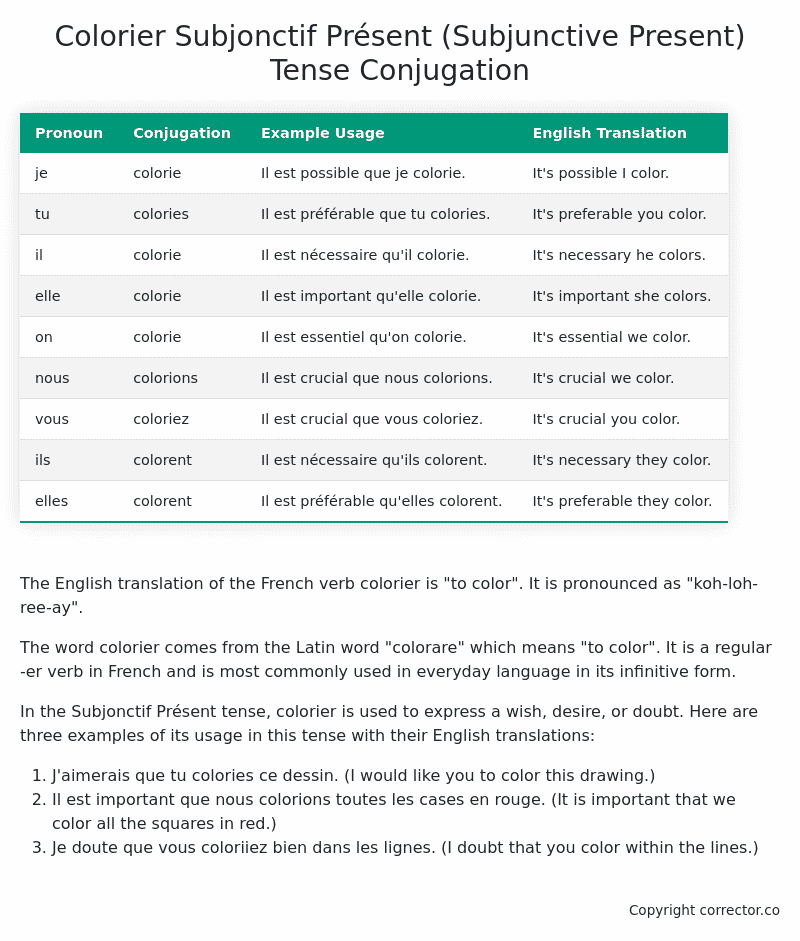Subjonctif Présent (Subjunctive Present) Tense Conjugation of the French Verb colorier
Introduction to the verb colorier
The English translation of the French verb colorier is “to color”. It is pronounced as “koh-loh-ree-ay”.
The word colorier comes from the Latin word “colorare” which means “to color”. It is a regular -er verb in French and is most commonly used in everyday language in its infinitive form.
In the Subjonctif Présent tense, colorier is used to express a wish, desire, or doubt. Here are three examples of its usage in this tense with their English translations:
- J’aimerais que tu colories ce dessin. (I would like you to color this drawing.)
- Il est important que nous colorions toutes les cases en rouge. (It is important that we color all the squares in red.)
- Je doute que vous coloriiez bien dans les lignes. (I doubt that you color within the lines.)
Table of the Subjonctif Présent (Subjunctive Present) Tense Conjugation of colorier
| Pronoun | Conjugation | Example Usage | English Translation |
|---|---|---|---|
| je | colorie | Il est possible que je colorie. | It’s possible I color. |
| tu | colories | Il est préférable que tu colories. | It’s preferable you color. |
| il | colorie | Il est nécessaire qu’il colorie. | It’s necessary he colors. |
| elle | colorie | Il est important qu’elle colorie. | It’s important she colors. |
| on | colorie | Il est essentiel qu’on colorie. | It’s essential we color. |
| nous | colorions | Il est crucial que nous colorions. | It’s crucial we color. |
| vous | coloriez | Il est crucial que vous coloriez. | It’s crucial you color. |
| ils | colorent | Il est nécessaire qu’ils colorent. | It’s necessary they color. |
| elles | colorent | Il est préférable qu’elles colorent. | It’s preferable they color. |
Other Conjugations for Colorier.
Le Present (Present Tense) Conjugation of the French Verb colorier
Imparfait (Imperfect) Tense Conjugation of the French Verb colorier
Passé Simple (Simple Past) Tense Conjugation of the French Verb colorier
Passé Composé (Present Perfect) Tense Conjugation of the French Verb colorier
Futur Simple (Simple Future) Tense Conjugation of the French Verb colorier
Futur Proche (Near Future) Tense Conjugation of the French Verb colorier
Plus-que-parfait (Pluperfect) Tense Conjugation of the French Verb colorier
Passé Antérieur (Past Anterior) Tense Conjugation of the French Verb colorier
Futur Antérieur (Future Anterior) Tense Conjugation of the French Verb colorier
Subjonctif Présent (Subjunctive Present) Tense Conjugation of the French Verb colorier (this article)
Subjonctif Passé (Subjunctive Past) Tense Conjugation of the French Verb colorier
Subjonctif Imparfait (Subjunctive Imperfect) Tense Conjugation of the French Verb colorier
Subjonctif Plus-que-parfait (Subjunctive Pluperfect) Tense Conjugation of the French Verb colorier
Conditionnel Présent (Conditional Present) Tense Conjugation of the French Verb colorier
Conditionnel Passé (Conditional Past) Tense Conjugation of the French Verb colorier
L’impératif Présent (Imperative Present) Tense Conjugation of the French Verb colorier
L’infinitif Présent (Infinitive Present) Tense Conjugation of the French Verb colorier
Struggling with French verbs or the language in general? Why not use our free French Grammar Checker – no registration required!
Get a FREE Download Study Sheet of this Conjugation 🔥
Simply right click the image below, click “save image” and get your free reference for the colorier Subjonctif Présent tense conjugation!

Colorier – About the French Subjonctif Présent (Subjunctive Present) Tense
Formation of the Subjonctif Présent
Common Everyday Usage Patterns
Interactions with Other Tenses
Summary
I hope you enjoyed this article on the verb colorier. Still in a learning mood? Check out another TOTALLY random French verb conjugation!


